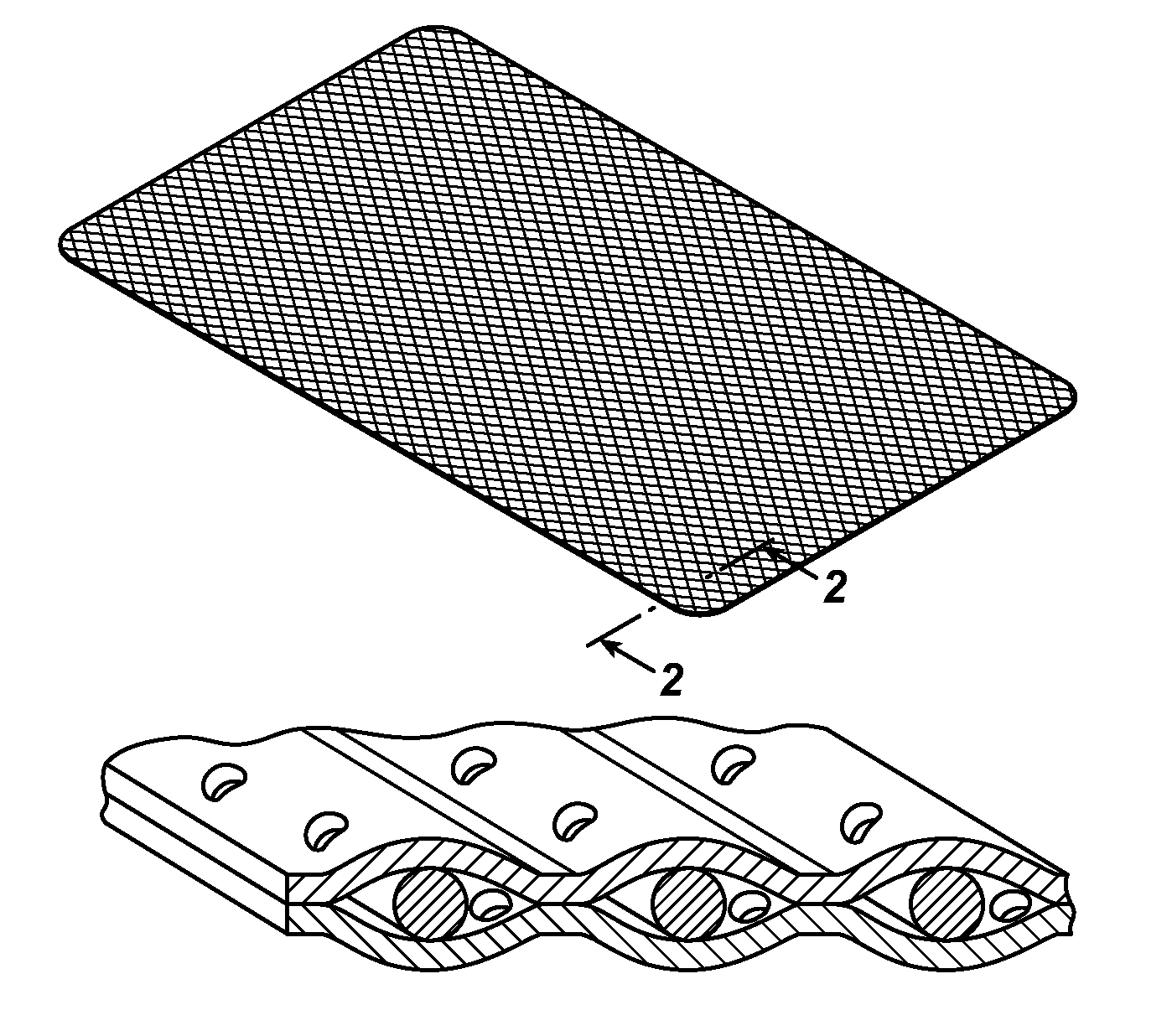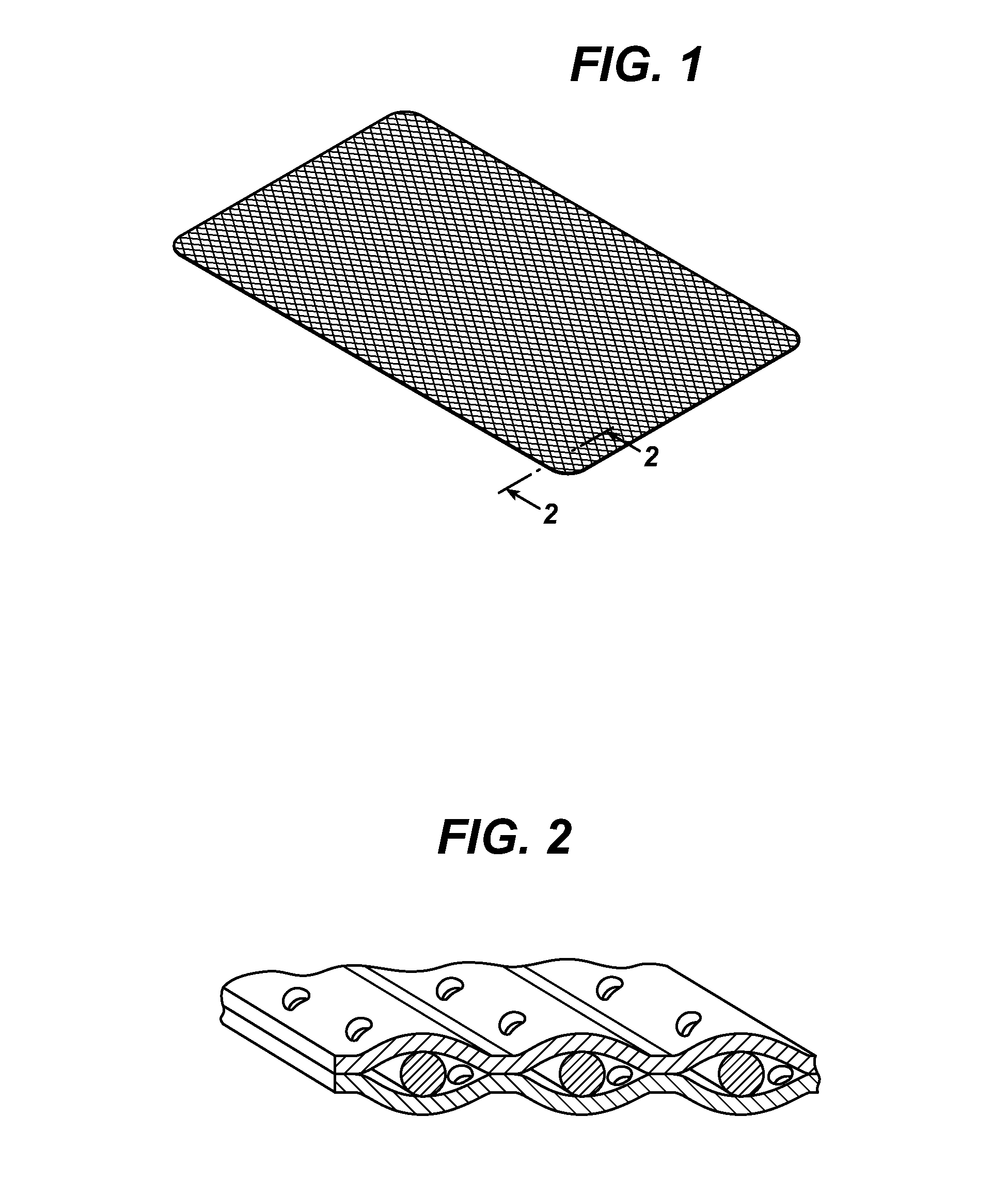Tissue repair devices of rapid therapeutic absorbency
a tissue repair and absorbency technology, applied in the field of soft tissue repair devices, can solve the problems of limited active agent amount that can be added to the implant, ineffective exposure of therapeutic fluid to the side without pores, and difficulty in preloading an implant with active agents, so as to minimize the possibility of tissue adhesion and fast absorb liquid
- Summary
- Abstract
- Description
- Claims
- Application Information
AI Technical Summary
Benefits of technology
Problems solved by technology
Method used
Image
Examples
example 1
Lightweight Mesh Laminated Between Two Porous Monocryl® Films
[0042]A lightweight polypropylene mesh having the same knitting structure as Ultrapro® brand mesh available from Ethicon, Inc., Somerville, N.J. U.S.A. but without the absorbable Monocryl® filaments-(poliglecaprone 25) was prepared. This mesh was heat laminated between two film layers. The first film consisted of 20 μm thick poliglecaprone 25 Monocryl® film that was extruded and laminated with an 8 μm thick poly-p-dioxanone (PDS) film. The pre-laminate was laser-cut with 1 mm holes or pores with a hole-to-hole distance of 5 mm. A second laminate layer comprising poliglecaprone 25 Monocryl film having a thickness of —————— was laser cut and pre-cut in the same manner as the first laminate layer above. Both films were placed in such a way that the holes or pores were not in alignment (i.e., offset) and were mounted as opposed outer films on the outer surfaces of the polypropylene mesh. The film mesh construct was laminated i...
example 2
Horizontal Dipping
[0048]This example demonstrated the wetting capabilities of the tissue repair devices of the present invention compared with non-porous devices.
[0049]Several 8×12 cm laminates with pore-containing films (pore diameter=1 mm, pore spacing=5 mm) were prepared according to Example 1. Several 8×12 cm laminates with nonporous films were prepared according to Example 1 with the exception that nonporous films were used in place of the porous films. The dry weight was determined for the porous and nonporous laminates.
[0050]The laminates were placed horizontally into a flat vessel containing 500 ml 0.2% Lavasept solution for 10 seconds (made from a Lavasept concentrate (20% PHMB), Lot 7383M03). The laminates were taken out and slightly shaken, to remove excess of liquid and weight was determined again.
Table 1 contains the results of the horizontal dipping experiments.
[0051]
TABLE 1HORIZONTAL DIPPING EXPERIMENTSDryWettedWeightWeights(Before(After 10 sWeightAvgdipping)dipping)i...
example 3
Horizontal Dipping in the OR and Handling Properties
[0055]Laminates were prepared in accordance with Example 1, but in an 18 cm×14 cm size. Pore-containing and nonporous laminates were placed through a conventional 12 mm trocar inserted through to the abdominal cavity of a swine. The implants were easily movable (sliding) at the intestine and then placed against the abdominal wall. Pore-containing and nonporous laminates were removably self-attaching to the abdominal wall. No instrument was needed to keep them up in place.
[0056]The same handling behavior was observed even for 10 second isotonic saline pre-wetted implants.
[0057]With the area weights calculated from Table 1 test articles had an attachment force to the abdominal wall greater than their own area weight of 20 mg / cm2 in the case of the dipped perforated film (calculated from 2 g of the 8×11 cm perforated wet implant in tab 1).
[0058]The devices of this invention were seen to be useful for adhesion prevention as a film barr...
PUM
 Login to View More
Login to View More Abstract
Description
Claims
Application Information
 Login to View More
Login to View More - R&D
- Intellectual Property
- Life Sciences
- Materials
- Tech Scout
- Unparalleled Data Quality
- Higher Quality Content
- 60% Fewer Hallucinations
Browse by: Latest US Patents, China's latest patents, Technical Efficacy Thesaurus, Application Domain, Technology Topic, Popular Technical Reports.
© 2025 PatSnap. All rights reserved.Legal|Privacy policy|Modern Slavery Act Transparency Statement|Sitemap|About US| Contact US: help@patsnap.com



